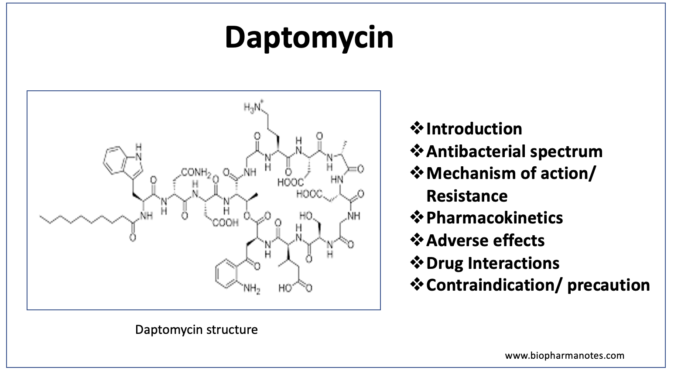
- Daptomycin is cyclic lipopeptide antibiotic which is derived from Streptomyces roseosporus.
- It was first discovered in early 1980s by scientists of Eli Lillly. Early work on daptomycin was ceased due to its side effects related to skeletal muscle like myopathy. Later on it was licensed by Cubist Pharmaceuticals in 1997 and research on it was resumed. It was approved by FDA for medical use in 2003.
Anti-bacterial spectrum of daptomycin
- It is effective against aerobic, facultative, and anaerobic gram-positive organisms. Also active against around 90% of species of staphylococci and streptococci and also E. faecalis and E. faecium.
- It is also effective against gram- positive bacteria which has developed resistance against certain antibiotics including methicillin- resistant Staphylococcus aureus (MRSA), vancomycin resistant Staphylococcus aureus (VRSA), and vancomycin resistant enterococci (VRE).
- It is not effective against gram-negative organisms.
Indications of daptomycin
- Used in treating various bacterial infection caused by gram-positive bacteria, including methicillin- resistant Staphylococcus aureus (MRSA) and vancomycin resistant enterococci (VRE). It can be used as alternative to linezolid or quinupristin/ dalfopristin for treating MRSA and VRE.
- Used to treat complicated skin and skin structure infection in both adult and pediatric patients.
- Used in bacteremia caused by S. aureus, including those with right sided infective endocarditis.
- Some of its off label uses include:
- Diabetic foot infection
- Prosthetic joint infection
- Native vertebral osteomyelitis
Mechanism of action of daptomycin
- It binds to bacterial cell membrane and causes rapid depolarization of membrane potential. This results in intracellular inhibition of protein, RNA and DNA synthesis which ultimately leads to cell death.
- It possesses concentration dependent bactericidal action.
- As it has unique mechanism of action, there is very rare chances of developing resistance, and no known resistance mechanism is there till today. However, there are increasing reports of daptomycin resistance in S. aureus, E. faecium and E. faecalis.
Pharmacokinetics
- It is administered via IV route. Around 90-94% of administered daptomycin binds to plasma proteins, mainly albumin. Its half-life is around 8-9 hours which allows once per day dosing. If the creatinine clearance of patient is less than 30 mL/min, it is administered once every 48 hours.
- Major portion is excreted unchanged in urine. Small amount is excreted via feces.
Adverse effects
- It can cause dose related myopathy and rhabdomyolysis. It can cause elevation of serum creatinine kinase. Hence, patients on daptomycin therapy should be continuously monitored for creatinine kinase level.
- It can also cause GI disturbance, constipation, insomnia, headache, and skin rashes. Eosinophilic pneumoniae may occur after 2-3 weeks of starting therapy and require cessation of therapy.
- Prolonged treatment with daptomycin may lead to development of superinfection including pseudomembranous colitis and Clostridium difficile- associated diarrhea (CDAD).
Drug Interactions
- Co-administration of statin (HMG CoA reductase inhibitors) with daptomycin may increase risk of skeletal muscle associated adverse effect. Hence, it should be used with caution when co-administering with statins.
- It should be used with caution when co-administering with aminoglycosides due to increased risk of nephrotoxicity.
Contraindications/ Precautions
- Contraindicated in patients with known hypersensitivity to daptomycin and any other components of the formulation.
- Daptomycin is inactivated by pulmonary surfactant so it should not be used in treating pneumoniae.
- It is not used in pediatric patients less than 1 year old.
- Used with care in elderly patients and in patients with renal impairment.
- It is pregnancy category B drug.
References
- https://www.ncbi.nlm.nih.gov/books/NBK470407/
- https://go.drugbank.com/drugs/DB00080
- Pharmacology and Pharmacotherapeutics. 24th edition.
- Goodman and Gillman Manual of Pharmacology and Therapeutics.
- Lippincott Illustrated Reviews Pharmacology, 6th edition.
- Ruiz ag et al. Daptomycin: an evidence-based review of its role in the treatment of Gram-positive infections. Infect Drug Resist. 2016; 9: 47–58.
- Heidary M et al. Daptomycin. Journal of Antimicrobial Chemotherapy. 2018; 73(1): 1–11.